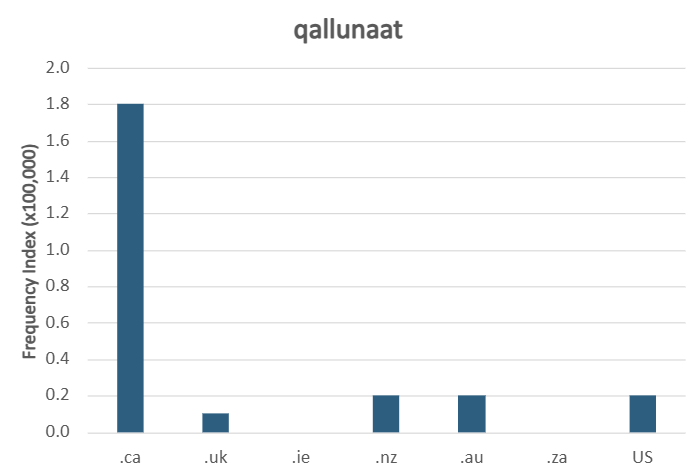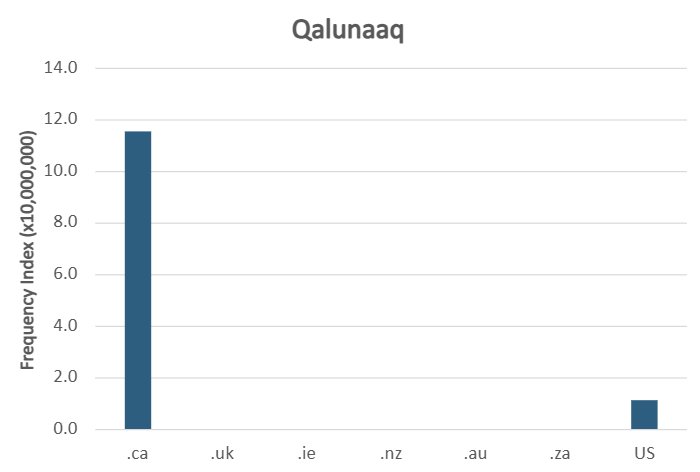Quick links
qalunaaq
< Inuktitut
DCHP-3.1 (Dec 2025)
Spelling variants:qallunaaq
qalunaaq (singular): a non-Inuit person; qalunaat (plural): non-Inuit people
n. — Territories, Indigenous resistance, Inuit
a white person; a southern Canadian.
Type: 1. Origin — The term is a borrowing from Inuktitut, the language of the Inuit peoples in Canada. The most likely meaning is 'those who care for material things' (see fist note below with quote from Freeman's memoir) (see Dorais 2010 for more detail). The term is used in English speech in the Territories, although it has little currency in southern Canada. Both qal(l)unaat and qal(l)unaaq are most prevalent in Canada (see Charts 1-4).
Qalunaat, the plural form, is the more prevalent form today (see Charts 1 and 2, which have different multipliers and difference of factor 100 between the singular and plural); qallunaaq, the singular, is in use as well (see quotations).
See also COD-2, s.v. "Qalunaaq", which is marked "Cdn (North)".
A comparison of Charts 1 and 2 with Charts 3 and 4 suggests that the preferred spelling with one 'l' is rivalled today by the form with two 'l's, qallunaat.
Qalunaat, the plural form, is the more prevalent form today (see Charts 1 and 2, which have different multipliers and difference of factor 100 between the singular and plural); qallunaaq, the singular, is in use as well (see quotations).
See also COD-2, s.v. "Qalunaaq", which is marked "Cdn (North)".
A comparison of Charts 1 and 2 with Charts 3 and 4 suggests that the preferred spelling with one 'l' is rivalled today by the form with two 'l's, qallunaat.
See: igloo(meaning 1a)
Mini Aodla Freeman offers interesting insights into the origin of the term:
“No wonder Inuit call them qallunaat. I said at the beginning that qallunaat means “people who pamper their eyebrows.” But I am not sure anymore if that’s what it means. It was never explained to me by any of my ancestors why the qallunaat were named that. [...] To come back to the word qallunaat: I have turned the word inside out to try and find the meaning. First of all, the word qallu can mean eyebrow; by adding an ending one has qallu-naaq, meaning one qallunaaq; qallu-naak — two qallunaaq; qallu-naat — many qallunaaq. The word implies humans who pamper or fuss with nature, of materialistic habit. Avaricious people. Qallu is also the beginning of the word qallunartak, material or fabric or anything that is manufactured or store-bought. It can also mean a rag made of material or fabric, or any material other than a material from nature. Somehow, I cannot see how the Inuit would have been impressed if the qallunaat pampered their eyebrows. I cannot imagine the qallunaat pampering their eyebrows when they did not care how they looked in the middle of the Arctic; even today, they do not seem to care how they look.” (Freeman 2015: 86)
“No wonder Inuit call them qallunaat. I said at the beginning that qallunaat means “people who pamper their eyebrows.” But I am not sure anymore if that’s what it means. It was never explained to me by any of my ancestors why the qallunaat were named that. [...] To come back to the word qallunaat: I have turned the word inside out to try and find the meaning. First of all, the word qallu can mean eyebrow; by adding an ending one has qallu-naaq, meaning one qallunaaq; qallu-naak — two qallunaaq; qallu-naat — many qallunaaq. The word implies humans who pamper or fuss with nature, of materialistic habit. Avaricious people. Qallu is also the beginning of the word qallunartak, material or fabric or anything that is manufactured or store-bought. It can also mean a rag made of material or fabric, or any material other than a material from nature. Somehow, I cannot see how the Inuit would have been impressed if the qallunaat pampered their eyebrows. I cannot imagine the qallunaat pampering their eyebrows when they did not care how they looked in the middle of the Arctic; even today, they do not seem to care how they look.” (Freeman 2015: 86)
A description in Dorais' (2010) linguistic introduction to the Inuit language, discusses "Non-identical types of humanity" from an Inuit perspective as shown in a 2010 quotation.
Quotations
1978
Qallunaaq (singular); qallunaat (plural): literally "people who pamper their eyebrows"; possibly an abbreviation of qallunaaraaluit: powerful, avaricious, of materialistic habit, people who tamper with nature.
1988
The common complaint of northerners is that their Arctic neighborhood is not understood by southerners, partly because southerners have no idea of life beyond the tree line. And so, if you catch that once-a-day flight from Ottawa to Baffin Island, you might come across scenes like these: Arctic Bay, near the northwestern tip of the Island: Two young men, Joanasie Naqitarvik, 24, and Sam Ipirq, 17, are skinning seals on the beach. They have shot eight on an all-night hunting expedition, seven ringed seals and one harp, and are deftly peeling the hides from the flesh. As a white outsider approaches, clutching camera, the older hunter looks up suspiciously, clutching bloodied knife, and asks, partly in jest, "What is this? Greenpeace?"
No. Merely a southern qallunaaq, a white man who has never seen a seal being skinned on an Arctic shoreline.
1997
"I get offended that every time there's a movie about the North there's always a Qallunaaq (non-Inuk) who steals the subject, who's in the centre of the action, while the Inuit take the backstage," Kunuk says.
2008
Using the same scientific techniques that white people (Qallunaats) have used to investigate the Inuit culture, Qallunologists (Inuit scientists) turn their investigative lens towards discovering the 'ins' and 'outs' of white man's culture. Although their findings are presented with humour and sharp wit, the underlying message is a sobering critical reflection into past and present racial prejudices, discrimination, and hegemonic social pillaging that European colonial domination has wrought upon Inuit culture.
2010
Non-identical types of humanity include, among others, First Nation Indians (allait, “others, strangers”)'' and Europeans (qallunaat, “outstanding eyebrows”) (Therrien 1987a). Qallunaat may be subdivided into qallunaatuinnait (“only real big eyebrows”; the Anglo), uiguit (“|[those who say] oui-oui”; the French), and tariup akianiittut (“those who are across the ocean”; Europeans), while the “others” comprise qirnitait (“the black ones”; blacks), inuujaqtut (“those who look like Inuit”; East Asians), and so on (Dorais 1988c).
2011
If white people can examine Inuit culture through the lens of science or anthropology, he reasons, then there ought to be an Inuit science of studying white people, known as Qallunaat in Inuktitut. Everything from etiquette - Qallunaats' passion for inane salutations and meaningless small-talk, for example - to the relentless quest to "keep up with the Joneses," to their need to repress natural bodily functions. In 2006, he teamed with filmmaker Mark Sandiford to create the Gemini-award-winning NFB docu-comedy Qallunaat! Why White People are Funny.
2015
Fortunately, Aodla's shock did not suppress her curiosity about the strange ways of the qallunaat (southerners). Twenty years later she wrote the first edition of Life Among the Qallunaat, published in 1978. Now the University of Manitoba Press, via their First Voices, First Texts series, has issued a new edition of the book that is truer to the author's original manuscript.
2019
Dear Qallunaat (white people),
We have been living in the same Nunavut cities and towns for some time now. In fact, the collective relationship is sometimes held up as innovative governance and Inuit self-determination.
Yet, you, the non-Inuit in our territory, rarely reflect that assumption, rather, the opposite. I have thought a lot about the level of damage having a highly transient, mostly white population does to Nunavut.
We have been living in the same Nunavut cities and towns for some time now. In fact, the collective relationship is sometimes held up as innovative governance and Inuit self-determination.
Yet, you, the non-Inuit in our territory, rarely reflect that assumption, rather, the opposite. I have thought a lot about the level of damage having a highly transient, mostly white population does to Nunavut.
2023
The history of Qallunaat (non-Inuit peoples) on Inuit Nunangat, or Inuit homelands, is a tale that leans towards extractive at best and acutely violent at worst. As with most interactions between Indigenous Peoples in what is now called Canada and eager explorers, settlers, and colonists, the relationship between Inuit and Qallunaat began from a place of altruism.
References
- COD-2
- Freeman (2015)
Images

Chart 1: Internet Domain Search, 26 November 2015

Chart 2: Internet Domain Search, 5 October 2012

Chart 3: Internet Domain Search, 22 April 2025
.png)